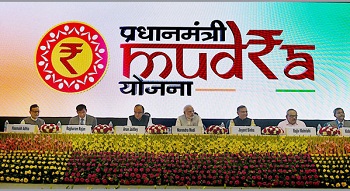Monetary Policy of RBI
Want to Become a Bank, Central / State Govt Officer in 2020?
Join the Most awarded Coaching Institute & Get your Dream Job


Now Prepare for Bank, SSC Exams from Home. Join Online Coure @ lowest fee
Lifetime validity Bank Exam Coaching | Bank PO / Clerk Coaching | Bank SO Exam Coaching | All-in-One SSC Exam Coaching | RRB Railway Exam Coaching | TNPSC Exam Coaching | KPSC Exam Coaching
MONETARY POLICY of RBI
Monetary policy is the process by which monetary authority of a country, generally central bank controls the supply of money in the economy by its control over interest rates in order to maintain price stability and achieve high economic growth. In India, the central monetary authority is the Reserve Bank of India (RBI). It is so designed as to maintain the price stability in the economy.
MONETARY POLICY COMMITTEE
- The Monetary Policy Framework Agreement was signed on February 20, 2015 between the RBI and Govt. of India.
- It is a committee of the Reserve Bank of India, headed by its Governor.
- It was set up by amending the RBI Act.
- The MPC is entrusted with the task of fixing the benchmark policy interest rate (repo rate) to contain inflation within the target level.
- MPC will have six members. Three each will be nominated by the government and the RBI and each member will have one vote.
- The majority voice of the committee will be final, the governor gets a casting vote in case of tie.
- Earlier, the governor’s word was final on the rates.
- The Monetary Policy Committee (MPC) is present in New Zealand, England, Canada, South Africa, Sweden, among others.
Members Nominated by RBI
- Urjit R Patel – Governor, RBI
- R Gandhi – Deputy Governor, RBI
- Michael Patra – Executive Director, RBI
Members Nominated by Government
- Pami Dua – Director, Delhi School Of Economics
- Chetan Ghate – Professor, Indian Statistical Institute
- Ravindra Dholakia – Professor, IIM, Ahmedabad
MONETARY POLICY INSTRUMENTS
There are mainly two types of monetary policy instruments. These are
- Indirect or Quantitative or General Instruments
- Direct or Qualitative or Selective Instruments
Indirect or Quantitative Instruments
Cash Reserve Ratio (CRR)
Cash Reserve Ratio is a certain percentage of bank’s Net Demand Time Liabilities (NDTL) which banks are required to keep with RBI in the form of cash balances. Higher the CRR with the RBI lower will be the liquidity in the system and vice versa. RBI is empowered to vary CRR between 15 percent and 3 percent. But as per the suggestion by the Narsimham committee Report the CRR was reduced from 15% in the 1990 to 5 percent in 2002. As of 8 February 2017, the CRR is 4.00 percent.
Statutory Liquidity Ratio (SLR)
The share of net demand and time liabilities that banks must maintain in safe and liquid assets, such as, government securities, cash, and gold with themselves. There was a reduction of SLR from 38.5% to 25% because of the suggestion by Narsimham Committee. The current SLR is 20.50%.
Bank Rate
The bank rate, also known as the discount rate, is the rate of interest charged by the RBI for providing funds or loans to the banking system normally for long term. This banking system involves commercial and co-operative banks, Industrial Development Bank of India, IFC, EXIM Bank, and other approved financial institutes. Funds are provided either through lending directly or discounting or buying money market instruments like commercial bills and treasury bills. Increase in Bank Rate increases the cost of borrowing by commercial banks which results in the reduction in credit volume to the banks and hence declines the supply of money. Increase in the bank rate is the symbol of tightening of RBI monetary policy.
Liquidity Adjustment Facility(LAF)
LAF is used to aid banks in adjusting the day to day mismatches in liquidity. LAF helps banks to quickly borrow money in case of any emergency or for adjusting in their SLR/CRR requirements. LAF consists of repo and reverse repo operations. Repo or repurchase option is a collaterised lending i.e. banks borrow money from Reserve bank of India to meet short term needs by selling securities to RBI with an agreement to repurchase the same at predetermined rate and date. The rate charged by RBI for this transaction is called the repo rate. Repo operations therefore inject liquidity into the system. Reverse repo operation is when RBI borrows money from banks by lending securities. The interest rate paid by RBI in this case is called the reverse repo rate.
Repo Rate
The (fixed) interest rate at which the Reserve Bank provides overnight liquidity to banks against the collateral of government and other approved securities under the liquidity adjustment facility (LAF).
Reverse Repo Rate
The (fixed) interest rate (currently 50 bps below the repo rate) at which the Reserve Bank absorbs liquidity, on an overnight basis, from banks against the collateral of eligible government securities under the LAF.
Reverse repo operation therefore absorbs the liquidity in the system. The collateral used for repo and reverse repo operations are Government of India securities.
Marginal Standing Facility Rate (MSF)
A facility under which scheduled commercial banks can borrow additional amount of overnight money from the Reserve Bank by dipping into their Statutory Liquidity Ratio (SLR) portfolio up to a limit [currently two per cent of their net demand and time liabilities deposits (NDTL)] at a penal rate of interest, currently 50 basis points above the repo rate. This provides a safety valve against unanticipated liquidity shocks to the banking system.
Open Market Operations(OMO)
These include both outright purchase and sale of government securities for injection and absorption of durable liquidity, respectively.
Market Stabilisation Scheme (MSS)
This instrument for monetary management was introduced in 2004. Surplus liquidity of a more enduring nature arising from large capital inflows is absorbed through sale of short-dated government securities and treasury bills. The cash so mobilised is held in a separate government account with the Reserve Bank. Recently, after Demonetisation RBI raises the MSS bond ceiling to Rs.6 trillion from Previously 30,000 Crore.
Direct or Qualitative Instruments
Loan to value ratio (LTV)/Marginal Requirement
Loan to Value is the ratio of loan amount to the actual value of asset purchased. RBI regulates this ratio so as to control the amount bank can lend to its customers. For example, if an individual wants to buy a car from borrowed money and the car value is Rs. 10 Lac, he can only avail a loan amount of Rs. 7 Lac if the LTV is set to 70%. RBI can decrease or increase to curb inflation or deflation respectively.
Consumer Credit Regulation
This refers to issuing rules regarding down payments and maximum maturities of instalment credit for purchase of goods.
Rataining Of Credit
Under this method there is a maximum limit to loans and advances that can be made, which the commercial banks cannot exceed. RBI fixes ceiling for specific categories. Such rationing is used for situations when credit flow is to be checked, particularly for speculative activities.
Moral Suasion
Moral Suasion refers to a method adopted by the central bank to persuade or convince the commercial banks to advance credit in accordance with the directives of the central bank in the economic interest of the country. Simply, the process in which the central bank requests or persuade the commercial banks to comply with the general monetary policy of the central bank is called a moral suasion. An example of this measure is to ask banks to reduce their Non-performing assets (NPAs).
Publicity
RBI uses media for the publicity of its views on the current market condition and its directions that will be required to be implemented by the commercial banks to control the unrest. Though this method is not very successful in developing nations due to high illiteracy existing making it difficult for people to understand such policies and its implications.
Direct Action
Under the banking regulation Act, the central bank has the authority to take strict action against any of the commercial banks that refuses to obey the directions given by Reserve Bank of India. There can be a restriction on advancing of loans imposed by Reserve Bank of India on such banks. e.g. – RBI had put up certain restrictions on the working of the Metropolitan co-operative banks. Also the ‘Bank of Karad’ had to come to an end in 1992.
Limitations Of Monetary Policy
In developing countries like India, Monetary Policy fails to show immediate or no results because of below factors:
- People do not employ alternative investment options. A large section of society still depends on saving accounts, fixed deposits, Public Provident Fund for investment. Commercial banks have large deposits. RBI is not the main or even prominent money supplier for these banks. So whatever monetary action central bank takes has little or late impact on the economy.
- Many people in rural areas are out of banking network and whatever RBI does has no impact on their financial activities.
- Monsoon uncertainty adversely affects food production and thereby cause food inflation. Monetary Policy has no impact on food inflation.





